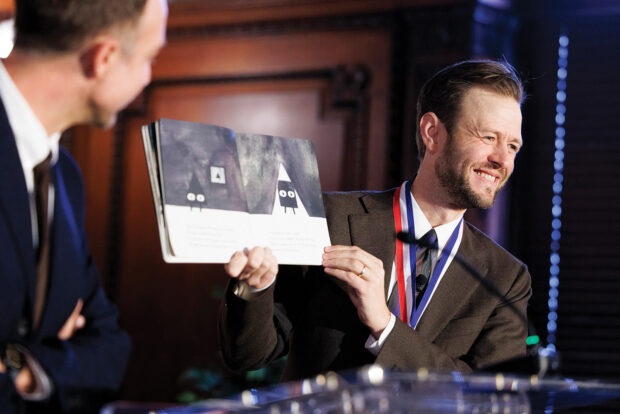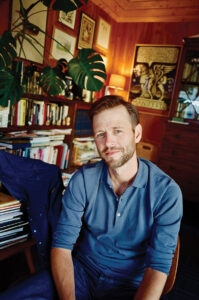By his senior year at Pomona, Mac Barnett ’04 knew what kind of stories captivated children.
What he didn’t know was how to write them.
Barnett, an English major fascinated by complex poetry and other pieces of fiction, spent his college summers as a camp counselor in Berkeley, California, reading to preschoolers. One book in particular, The Stinky Cheese Man and Other Fairly Stupid Tales by Jon Scieszka, kindled Barnett’s love for children’s literature.
“I thought, ‘This is the kind of thing I love and that I study, but these 4-year-olds aren’t going to get it,’” Barnett recalls. “But when I read this book to them, they were getting the most sophisticated jokes. That’s when I figured out that kids were the best audience for the kind of stories that I liked.”
Impassioned his senior year to write for children, Barnett convinced the late author and Pomona Professor David Foster Wallace to let him into his creative writing class. On top of challenging his students to shed their writing habits, Barnett says, Wallace underscored the importance of the writer-reader relationship.
“He had such a focus on taking care of the reader,” Barnett recalls. “Him explaining how you, at a desk alone in a room, should have your audience in mind and consider how a sentence or plot twist is going over with the reader—it just made so much sense, especially for picture books, which are usually read out loud to kids. Consider the adult reading and the kid listening.”
Pomona taught me how to think from different perspectives, to look at problems in different ways, to let go of certainty, which I think is often the enemy of literature.”
-Mac Barnett ’04
Twenty years after graduating from Pomona, Barnett has written more than 60 books for children and won myriad awards.
In February, The New York Times best-selling author was appointed the ninth National Ambassador for Young People’s Literature by the Library of Congress. During his two-year term, Barnett will travel the country championing children’s picture books as a quintessential American art form.
“Taking children’s books seriously requires us to take children seriously,” he says. “Children are misunderstood, overlooked, dismissed, not listened to—and really caring about the books they read requires us to see them for who they really are [as] dimensional human beings who feel deeply and think in interesting and complicated ways.”
Learning how to think
Barnett wanted to be a writer long before leaving the Bay Area for Pomona in the early 2000s.
He started writing poetry in middle school, then plays and novels as he got older. At Pomona, he wrote sketch comedy and developed an interest in journalism and nonfiction that he once thought would turn into a future in academic writing.
As Barnett pondered his career prospects, he says Pomona professors like Paul Saint-Amour encouraged him to be skeptical, thoughtful and curious.
“Pomona taught me how to think from different perspectives, to look at problems in different ways, to let go of certainty, which I think is often the enemy of literature,” Barnett adds. “I would be a much less interesting writer if I hadn’t gone to Pomona.”
One day his senior year, Barnett mentioned to a Pitzer College friend that in the summer he’d discovered the book Stinky Cheese Man while at camp. The friend was Scieszka’s daughter, who introduced Barnett to her father shortly thereafter.
In 2008, Scieszka was named the first National Ambassador for Young People’s Literature. A year later, Scieszka helped Barnett publish his first book, Billy Twitters and His Blue Whale Problem.
Barnett says that, when he left Pomona, he told himself he would take a year and try to write a picture book. If it didn’t work out, he would go back to get a Ph.D. somewhere.
“Even when I got my third book published,” he says, “I didn’t think writing would be a career.”

Mac Barnett ’04, seen here at his inauguration as National Ambassador for Young People’s Literature, draws inspiration from art, music and theatre, and incorporates the complexities of those mediums into his stories. (Shawn Miller/Library of Congress)
Writing for young readers
Barnett learned early in his career to listen to children.
Writing for kids and adults is similar, he says, in that both appreciate the great themes of literature—love, jealousy, betrayal, discovery. Barnett hit his stride as an author when he started focusing on concerns children have and asking young readers questions rather than answering them.
In 2017, Barnett published The Wolf, the Duck, and the Mouse—the picture book he says epitomizes his approach to writing.
“What’s powerful about picture books is that they can go very deep very fast,” he says. “It’s a short form of literature—32 pages, sometimes 40—and not a lot of words per page. But it can get to some of life’s deepest questions, and I feel I did that [with The Wolf, the Duck, and the Mouse].”
Barnett draws inspiration from art, music and theatre, and incorporates the complexities of those creative mediums into his stories. He says that, because children tend to be insulated from much of the world, children’s books tend to feel cloistered from the rest of literary culture—but that the best ones are sophisticated, thought-provoking and challenging.
“As adults, when we encounter something we don’t understand, we often push it aside because it makes us feel stupid,” he says. “But kids just bravely charge into challenging texts. It’s really inspiring to watch.”
With more than 5 million copies sold and a stop-motion animated series on Apple TV+ based on his and co-creator Jon Klassen’s Shapes series of picture books, Barnett recognizes the responsibility he has in writing for a time in a young reader’s life.
As National Ambassador, he has the platform to enlighten adults on the power of children’s books and the brilliance of the kids who read them. He says that he appreciates living in the space of early childhood, likening it to a train station where kids are constantly passing through.
“I’m sitting there [with my] violin … [trying] to play them a beautiful piece of music that makes sense in that moment,” he says. “Maybe they’ll remember the tune when they get where they’re going, but even if they don’t, all that matters is that I played a good piece while they were there.”

